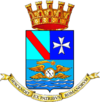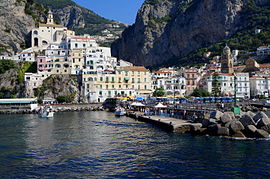Amalfi
| Amalfi | ||
|---|---|---|

|
|
|
| Country | Italy | |
| region | Campania | |
| province | Salerno (SA) | |
| Coordinates | 40 ° 38 ' N , 14 ° 36' E | |
| height | 6 m slm | |
| surface | 6 km² | |
| Residents | 5,004 (Dec 31, 2019) | |
| Population density | 834 inhabitants / km² | |
| Factions | Lone, Pastena, Vettica, Pogerola, Tovere | |
| Post Code | 84011 | |
| prefix | 089 | |
| ISTAT number | 065006 | |
| Popular name | Amalfitani | |
| Patron saint | Sant'Andrea | |
| Website | Amalfi | |
 Amalfi cityscape |
||
Amalfi is a small town with 5004 inhabitants (as of December 31, 2019) in Italy in the province of Salerno in the Campania region .
geography
location
Amalfi is located on the Gulf of Salerno on the Tyrrhenian Sea 26 km west of Salerno and 73 km south-east of Naples . The city lies on a steep rocky coast, the Amalfi Coast , which has been declared a World Heritage Site by UNESCO , and extends from the coast into a narrow valley of the Monti Lattari, which occupy the Sorrento peninsula . The actual city can only use an area of around 3 km² for development.
Districts
The municipality of Amalfi also includes Lone, Pastena, Vettica, Pogerola and Tovere.
Neighboring communities
The neighboring municipalities are Atrani , Ravello and Positano .
region
Amalfi is part of the South Center System (SC) of Europe. The next "secondary metropolis" is Naples, Salerno is the next "regional center" and provincial capital.
history
Establishment uncertain
According to unsecured information, Amalfi was founded in 320 AD by soldiers of Emperor Constantine . These came from the Adriatic coastal town of Melphe (a Melphe = from Melphe), from which the name Amalfi is supposed to be derived.
5th to 12th century
Due to the lack of fertile farmland, the Amalfi people turned early to the sea and thus to sea trade. Since the 6th century the city was under the Exarchate of Ravenna , but enjoyed extensive autonomy due to its importance for Byzantium . The city finally gained statehood in the 9th century. By clever tactics with the surrounding powers (Byzantines, Lombards , the emperor and the pope ) Amalfi succeeded in becoming one of the leading powers in Italy. In 846 the city sent ships to defend Rome . Together with the fleets of Naples and Gaeta , it was possible to defeat the Saracens at Ostia . Amalfi subsequently became the first of the so-called Maritime Republics (alongside Genoa , Pisa , Venice , Ancona , Gaeta, Noli and Ragusa ).
Amalfi merchants maintained bases in all the metropolises of the Mediterranean , for example in Córdoba , Antioch , Cairo , Constantinople and Durazzo . In the 10th century Amalfi was the hub of trade between the Orient and Occident . Arab travelers praised it as the "richest and most glamorous city" in the Longobard Empire. At that time, the Amalfi Republic, which also included the neighboring towns of Atrani , Ravello , Scala , Minuto, Maiori and Minori, had well over 50,000 inhabitants.
Amalfi developed Italy's first codification of the law of the sea , the Tabula Amalphitana , which was still valid throughout the Mediterranean region well beyond the lifespan of the Maritime Republic. Amalfi minted its own coins and was known throughout the Mediterranean for its shipyards.
In the 11th century, at the height of its economic power, Amalfi was threatened by the Normans and at the same time weakened by internal unrest. In 1073 the Norman Robert Guiskard conquered the city. As a result, Amalfi lost its importance mainly to Venice. Two devastating Pisan attacks in 1135 and 1137 ended Amalfi's heyday.
The destroyed trade flourished again. While Venice rose in western Genoa and in the Adriatic-eastern Mediterranean, Amalfi and Salerno developed remarkable trade into Muslim Sicily and North Africa. In the Levant trade centers emerged after the conquests of the Crusaders.
13th to 19th centuries
A tsunami triggered by an earthquake , which Francesco Petrarca described in his Epistolae familiares , literally drowned parts of the city into the sea on November 25, 1343. Politically, it became dependent on Pisa . In 1582 Amalfi came to the Kingdom of Naples and shared its fate until the fall of the Bourbon rule in 1860. Due to its remote geographical location, the city continued to lose importance during the 17th and 18th centuries; Furthermore, until the middle of the 19th century it could only be reached by sea. Amalfi was sometimes used by pirates as a hiding place or rest stop. The production of paper in the water mills of the mill valley of Amalfi and the production of pasta were the most important branches of industry during this period.
In the years 1875/1876 the Danish landscape painter Carl Frederic Aagaard visited Amalfi, among others, on the occasion of an extensive study trip. During this time, a number of well-known oil paintings of the city and landscape were created.
From the 20th century
tourism
With the flourishing of tourism from the middle of the 20th century, the city's economy recovered, new accommodations and leisure activities increased the number of visitors enormously in the summer months.
Cittaslow
The city is a member of the Cittàslow , a movement founded in Italy in 1999 to slow down and increase the quality of life in cities through environmental policy, infrastructure policy, urban quality, appreciation of autochthonous products, hospitality, awareness and quality of the landscape.
Attractions
- The cityscape impresses with its facility on a steep slope.
- The 10th century cathedral is the cathedral of the Archdiocese of Amalfi-Cava de 'Tirreni . In the 13th century it was converted to the Arab-Norman style, later in the Baroque style . In the 18th century the cathedral received the colored mosaic facade. It was completed in 1891 based on plans by the architect Enrico Alvino. The entire structure consists of the cloister of paradise, the crucifix basilica with the diocesan museum ( Museo Diocesano di Amalfi ), the crypt and the actual cathedral. The interior of the cathedral ( Cattedrale di Sant'Andrea ) was laid out with three naves. The bones of the Apostle Andrew , the patron saint of Amalfi, are kept in its crypt . The cathedral is considered the symbolic and tourist center of Amalfi.
Mosaic in the facade
- Citizen Museum ( Palazzo Municipio ) in the town hall, documents the extensive history of the city
- Old shipyard ( Corso Roma ), here above all the history of seafaring is worked out; the shipyard building, converted into a museum, is the only one of its kind that has been preserved in southern Italy
- A covered and built-up street ( Supportico Sant'Andrea )
- Monument to Flavio Gioia , the alleged inventor of the compass
- Paper museum
- Rural lemon museum
- The coastal road Strada Statale 163 Amalfitana is considered one of the most beautiful in Europe
- Valley of the Ironworks ( Valle delle Ferriere )
Amalfi Prize
The prestigious Premio Amalfi , a European prize for sociology and social sciences, is awarded annually in Amalfi.
See also
literature
- John Morrissey: Amalfi - Modernism in the Middle Ages . Mandelbaum Verlag, Vienna 2020, ISBN 978-3-85476-860-9 .
Web links
- The history of the Maritime Republic of Amalfi in the Middle Ages
- Amalfi Guide: Amalfi to Live
- Moving on the Coast: Bus and Boat Timetable
Individual evidence
- ↑ Statistiche demografiche ISTAT. Monthly population statistics of the Istituto Nazionale di Statistica , as of December 31 of 2019.
- ↑ Walter Christaller: The basic framework of spatial order in Europe. Frankfurt a. M. 1950. pp. 5 ff., 43 ff.
- ^ NJG Pounds: Historical and Political Geography of Europe. Braunschweig. 1950, p. 107
- ↑ a b c d Naples. Amalfi Coast. Cilento . Dumont Travel Paperback, ISBN 978-3-7701-7241-2 ; Page 219ff








